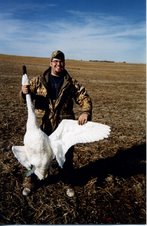
My dad said that last weekend was probably the coldest weather he had ever hunted in. However, he has been colder while hunting. These days my dad owns warmer clothing and knows how to dress for the elements. Friday was the warmest day of the hunt; it was a balmy 16 degrees with no wind in Brookings, South Dakota.
This was my first pheasant-hunting trip to the South Dakota. I have chased snow geese there in the spring for several consecutive seasons, and I’ve always wanted to go there in the fall.
The plan was for our group to hunt public land the majority of the time. South Dakota has state funded Walk-In Areas, which are private lands, open for public hunting. The Walk-In program is similar to the P.L.O.T.S. (Private Lands Open to Sportsman), program found in North Dakota. With 13 hunters and 9 dogs we were planning on hunting big cover and using blockers to surround the birds.
Thursday, November 30th was the first day of our hunt. Because of the South Dakota pheasant season being open for several weeks, the birds were skittish and wary. Right away we found them in the thickest cover available, but the birds did not hold very well. A few times there were birds that took off flying while the group was still getting out of the trucks.
Late in the pheasant season I encourage pheasant hunters to be especially aware of the noise they make (no slamming truck doors, yelling at bird dogs, etc.). Walking the cover into the wind helps to reduce noise, while also being the ideal way for sniffing dogs to mind scent. With extra thought and planning late fall hunting can still be successful.
South Dakota pheasant hunting is like Pizza. When it’s from your favorite restaurant it’s great, and when it is a cheap frozen brand it is still pretty good. We managed to have decent hunting, averaging 2 to 3 pheasants per walk. At 10 am sharp, the starting time in South Dakota, our group would be in position to push larger grasslands. Half the group would walk through the fields, and the other half would block the ends of the fields. This system worked well for many pheasant hunters in the past.
In theory pheasants should run through the field, holding near the edge, providing blocks and walkers good shooting opportunities. That is textbook pheasant hunting. Early on in our trip though we found that the birds were flushing ahead of the walkers, flying out the sides of the fields, and therefore avoiding the blockers. With birds flying out on the sides we had to rethink a few things and make adjustments. Still the majority of the roosters we bagged were ones that chose to hold tight rather than fly.
Pheasants basically have two defense mechanisms. Either they fly or they run and hide. The experts say that over time hunters have harvested a higher majority of the flyers making the pheasant more genetically prone to run. We must have been hunting in an area with a high concentration of flyers.
Each day our group saw a lot of birds, but the vast majority were hens. This is to be expected this late in the season because other hunters have trimmed the rooster population down. I read somewhere that up to 80% of rooster pheasants are shot during each hunting season. Don’t worry; there are still plenty of roosters that escaped our hunting party to provide more birds for next year.
In the afternoons we broke into smaller groups and hunted smaller cover. Pheasants are an edge bird; sometimes a small and thick piece cover can provide quick birds.
As the sun was going down across the vast Dakota prairie, 6 of us followed 2 housedogs through the field for the last walk of the trip. On that walk the 6 of us flushed 3 roosters and harvested all 3 of them. It was bitter outside, but it was a sweet way to end my first South Dakota pheasant hunt.

No comments:
Post a Comment